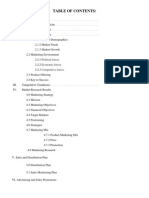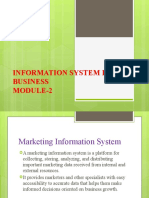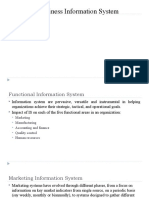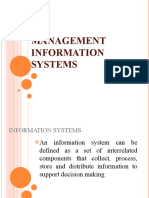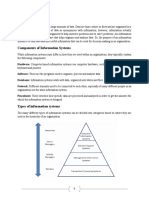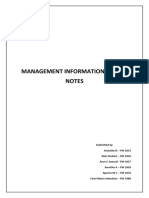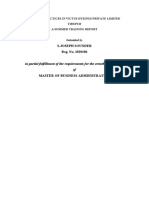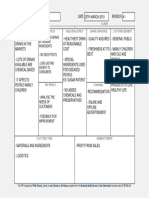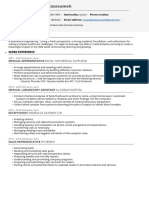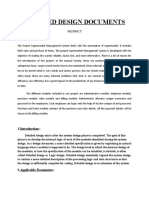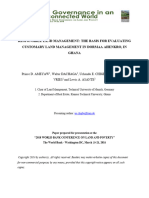0 ratings0% found this document useful (0 votes)
308 viewsSales and Marketing Information Systems
Sales and Marketing Information Systems
Uploaded by
Jeffry MahiFunctional business systems are information systems that support key business functions like accounting, finance, marketing, operations management, and human resources. There are several types of these systems, including sales and marketing systems, manufacturing and production systems, finance and accounting systems, and human resource systems. These systems help organize, store, and distribute information to managers to help with decision making in areas like product development, sales forecasting, production scheduling, and employee skills development.
Copyright:
© All Rights Reserved
Available Formats
Download as DOCX, PDF, TXT or read online from Scribd
Sales and Marketing Information Systems
Sales and Marketing Information Systems
Uploaded by
Jeffry Mahi0 ratings0% found this document useful (0 votes)
308 views2 pagesFunctional business systems are information systems that support key business functions like accounting, finance, marketing, operations management, and human resources. There are several types of these systems, including sales and marketing systems, manufacturing and production systems, finance and accounting systems, and human resource systems. These systems help organize, store, and distribute information to managers to help with decision making in areas like product development, sales forecasting, production scheduling, and employee skills development.
Original Title
FIS
Copyright
© © All Rights Reserved
Available Formats
DOCX, PDF, TXT or read online from Scribd
Share this document
Did you find this document useful?
Is this content inappropriate?
Functional business systems are information systems that support key business functions like accounting, finance, marketing, operations management, and human resources. There are several types of these systems, including sales and marketing systems, manufacturing and production systems, finance and accounting systems, and human resource systems. These systems help organize, store, and distribute information to managers to help with decision making in areas like product development, sales forecasting, production scheduling, and employee skills development.
Copyright:
© All Rights Reserved
Available Formats
Download as DOCX, PDF, TXT or read online from Scribd
Download as docx, pdf, or txt
0 ratings0% found this document useful (0 votes)
308 views2 pagesSales and Marketing Information Systems
Sales and Marketing Information Systems
Uploaded by
Jeffry MahiFunctional business systems are information systems that support key business functions like accounting, finance, marketing, operations management, and human resources. There are several types of these systems, including sales and marketing systems, manufacturing and production systems, finance and accounting systems, and human resource systems. These systems help organize, store, and distribute information to managers to help with decision making in areas like product development, sales forecasting, production scheduling, and employee skills development.
Copyright:
© All Rights Reserved
Available Formats
Download as DOCX, PDF, TXT or read online from Scribd
Download as docx, pdf, or txt
You are on page 1of 2
Functional business systems are Information systems that focus on operational and managerial
applications in support of basic business functions. Examples information systems that support
applications in accounting, finance, marketing, operations management, and human resource
management. According to Khanore, et al. Information system can be classified by the specific
organizational function to Sales and marketing systems, Manufacturing and Production systems,
Finance and accounting system and Human resource system
Sales and Marketing Information Systems :
The sales and marketing function is responsible for selling the organization's product or
service. Marketing is concerned with identifying the customers for the firm's products or
services, determining what they need or want, planning and developing products and services to
meet their needs, and advertising and promoting these products and services. Sales are concerned
with contacting customers, selling the products and services, taking orders, and following up on
sales. Sales and marketing information systems support these activities .According to Shim, a
marketing MIS supports managerial activity in the areas of product development, marketing mix,
distribution, pricing decisions, promotional effectiveness, and sales forecasting.
Manufacturing and Production Information Systems
The manufacturing and production function is responsible for actually producing the
firm's goods and services. Manufacturing and production systems deal with the planning,
development, and maintenance of production facilities; the establishment of production goals;
the acquisition, storage, and availability of production materials; and the scheduling of
equipment, facilities, materials, and labor required to fashion finished products. Manufacturing
and production information systems support these activities . According to Hernandez & Rivera
the production information system is a computer program that manages a database of
information related to production. According to Shim the mission of a manufacturing
information system is to apply computer technology to improve the process and the efficiency of
a manufacturing system, thus raising quality of products and lowering the manufacturing costs.
In other words, a manufacturing system is a system that takes material, equipment, data,
management, and information systems technology as the input and uses manufacturing and
information process to generate better final products as output
Finance and Accounting Information Systems
Finance function is responsible for managing the firm`s financial assets, such as cash,
stock, bonds, other investment. The accounting function is responsible for maintaining and
managing the firm`s financial records such as receipts, depreciation, payroll etc . According to
Shim. The fundamental task of accounting software is to automate the routine chore of entering
and posting accounting transactions. This information is organized in an electronic format so as
to produce financial statements and can be accessed immediately to assist in the management of
the firm. A financial management information system provides financial information to all
financial managers within an organization .Financial decisions are typically based on information
generated from the accounting system
Human Resource Information Systems
Human Resources Information Systems are process of producing, organizing, storing and
distributing manpower information to help the organization managers at various levels, in order
to make proper decisions. Nowadays the majority of successful companies are using human
resource information systems to support daily operations of human resources Khanore, et al.,The
human resources function is responsible for attracting, developing, and maintaining the firm's
work force. Human resources information systems support activities such as identifying potential
employees, maintaining complete records on existing employees, and creating programs to
develop employees' talents and skills.
Conclusion
There are different types of information systems used in business organizations. transaction
processing systems designed to records the daily routine transactions necessary to the conduct of
the business. Office automation systems designed to support office tasks. Process control
systems designed to Monitor and control industrial or physical processes .
Management information system (MIS) basically concerned with converting data from internal
sources into information which is then communicated to managers at all the levels, in all
functions to make timely and effective decisions for planning, directing and controlling the
activities for which they are responsible .Decision support systems designed to help manager in
decision making that needs modeling, formulation, calculating, comparing, selecting the best
option or predict the scenarios .Executive information systems provides senior managers with a
system to assist in taking strategic and tactical decisions . Expert system program designed to
emulate human reasoning . This study attempts to clarify the role of each type of information
systems in business organizations.
.
You might also like
- Marketing Plan11Document15 pagesMarketing Plan11Jae Lani Macaya Resultan91% (11)
- Chan - Final Activity 1 - MisDocument3 pagesChan - Final Activity 1 - MisKenn ChanNo ratings yet
- MIS-Unit 3Document24 pagesMIS-Unit 3BhagwatiNo ratings yet
- Mod IIDocument40 pagesMod IIAkshay AkshayNo ratings yet
- Why Are Organisations Trying To Integrate Their Business Process MIS ASSDocument14 pagesWhy Are Organisations Trying To Integrate Their Business Process MIS ASSAyanleke Julius Oluwaseunfunmi0% (1)
- MIS 5TH UINT NotesDocument6 pagesMIS 5TH UINT NotesMala niveNo ratings yet
- Importance of Information SystemsDocument148 pagesImportance of Information Systemsbauuaaa100% (1)
- Management Information System: Assignment 1Document5 pagesManagement Information System: Assignment 1Muhammad Arslan Wajid100% (1)
- IsmDocument22 pagesIsmdevenrawat.03No ratings yet
- DPB1033 Management Information System: Information Systems and Organization StrategyDocument20 pagesDPB1033 Management Information System: Information Systems and Organization StrategyNur AdreanaNo ratings yet
- A Management Information System Restaurant Case StudyDocument2 pagesA Management Information System Restaurant Case StudyGanapati KattigeNo ratings yet
- Nama: Arif Andri Panjaitan NIM: 7193210004Document3 pagesNama: Arif Andri Panjaitan NIM: 7193210004Arif andri PanjaitanNo ratings yet
- 6 - Business Information SystemDocument10 pages6 - Business Information SystemBshwas TeamllcenaNo ratings yet
- Week 5 - Chapter 2: Mini Test: (75 Minutes)Document4 pagesWeek 5 - Chapter 2: Mini Test: (75 Minutes)chauanhnguyen0310No ratings yet
- Information & Business Economic AnalysisDocument9 pagesInformation & Business Economic AnalysisDhiraj KumarNo ratings yet
- Assignment 1 1.0 Definition of Information System 1.1 Information SystemDocument8 pagesAssignment 1 1.0 Definition of Information System 1.1 Information SystemJiana NasirNo ratings yet
- MIS With Functional Areas of BusinessDocument33 pagesMIS With Functional Areas of BusinessShubham Agarwal100% (1)
- Lesson 4Document23 pagesLesson 4Ahmed MujtabaNo ratings yet
- Marketing Information SystemDocument9 pagesMarketing Information SystemRahul ItankarNo ratings yet
- Types of Information System: TPS, DSS & Pyramid DiagramDocument6 pagesTypes of Information System: TPS, DSS & Pyramid DiagramsureshkaswanNo ratings yet
- Ae 23 It Application Tools in Business Pre FinalDocument3 pagesAe 23 It Application Tools in Business Pre FinalNina Mae DiazNo ratings yet
- IntroductionDocument34 pagesIntroductionSudani AnkitNo ratings yet
- Unit III Types of ISMDocument5 pagesUnit III Types of ISMhsisjsboNo ratings yet
- Financial Information SystemDocument7 pagesFinancial Information SystemAvisek shresthaNo ratings yet
- Pyramid Diagram of Organizational Levels and Information RequirementsDocument5 pagesPyramid Diagram of Organizational Levels and Information RequirementsHaris ShahidNo ratings yet
- Management Information SystemDocument10 pagesManagement Information SystemPankaj Kr LakraNo ratings yet
- That Helps To Evaluate Which Vendors More Closely Match Your List of PrioritiesDocument3 pagesThat Helps To Evaluate Which Vendors More Closely Match Your List of PrioritiesMs. ANo ratings yet
- What Is Management Information SystemDocument3 pagesWhat Is Management Information SystemRuffa Mae MaldoNo ratings yet
- Unit-2-Business Application of Information SystemDocument25 pagesUnit-2-Business Application of Information Systemsrinivasa_rcNo ratings yet
- Information Systems: Instructor University of Agriculture, Faisalabad Sub-Campus Burewala/Vehari, PakistanDocument23 pagesInformation Systems: Instructor University of Agriculture, Faisalabad Sub-Campus Burewala/Vehari, PakistantwinklenoorNo ratings yet
- Management Information SystemDocument7 pagesManagement Information SystemMehedi BappiNo ratings yet
- The Mis Job Today: AccountingDocument6 pagesThe Mis Job Today: AccountingSuresh Kumar V SuriNo ratings yet
- Global E Business and CollaborationDocument2 pagesGlobal E Business and CollaborationNurinda Ramadhanti PratamaNo ratings yet
- Mis Notes Before Mid CompleteDocument12 pagesMis Notes Before Mid Completesamisultan6789012No ratings yet
- Itm Module IIIDocument8 pagesItm Module IIIPoonam SinghNo ratings yet
- Test 2Document48 pagesTest 2Daniel DjpNo ratings yet
- Untitled 1Document4 pagesUntitled 1Shekhar RaviNo ratings yet
- MIS-Unit 1Document61 pagesMIS-Unit 1BhagwatiNo ratings yet
- Six Major Types of Information SystemsDocument2 pagesSix Major Types of Information SystemsantaraNo ratings yet
- U: 1 B M T: NIT Asics OF Anagement HeoryDocument15 pagesU: 1 B M T: NIT Asics OF Anagement HeoryPradnya KadNo ratings yet
- RetailDocument5 pagesRetailSansNo ratings yet
- Information Systems at Pepsi Co Sri LankaDocument13 pagesInformation Systems at Pepsi Co Sri Lankasooriyampola100% (3)
- Mis Module 2Document33 pagesMis Module 2Tinku JoyNo ratings yet
- Marketing Research MethodDocument25 pagesMarketing Research MethodJeff LacasandileNo ratings yet
- Pyramid Diagram of Organizational Levels and Information RequirementsDocument5 pagesPyramid Diagram of Organizational Levels and Information RequirementsMohan William Sharma100% (1)
- Overview of Information SystemDocument24 pagesOverview of Information SystemajayNo ratings yet
- Full Set-Management Information SystemDocument13 pagesFull Set-Management Information SystemmaiNo ratings yet
- 6 Categories of Information SystemDocument10 pages6 Categories of Information SystemCharmaine MagtangobNo ratings yet
- Mis Assignment FinalDocument24 pagesMis Assignment FinalDigambar LohakareNo ratings yet
- Structure of MISDocument18 pagesStructure of MISankit67% (12)
- 10 Types of Information SystemsDocument6 pages10 Types of Information SystemsAmina AjemaNo ratings yet
- The Important Functional Subsystems Are The Following.: 1. Production SubsystemDocument7 pagesThe Important Functional Subsystems Are The Following.: 1. Production Subsystempawan bathamNo ratings yet
- Study Guide Enterprise SystemsDocument7 pagesStudy Guide Enterprise Systemsgosaye desalegnNo ratings yet
- MIS Presentation ExclusiveDocument72 pagesMIS Presentation ExclusiveManish SinghNo ratings yet
- Management Information System NotesDocument13 pagesManagement Information System NotesSasidharan Sajeev ChathathuNo ratings yet
- PlanningDocument11 pagesPlanningSwati SinghNo ratings yet
- Infor Sys Final ProjectDocument92 pagesInfor Sys Final ProjectAbeer AlshebamiNo ratings yet
- Introduction To Information SYSTEMS (IM 111) : Types of Information Systems Instructor: Augustino Mwogosi Room AB 205Document36 pagesIntroduction To Information SYSTEMS (IM 111) : Types of Information Systems Instructor: Augustino Mwogosi Room AB 205Alfred godsonNo ratings yet
- (Networks), and Stored Data (Data Resources)Document8 pages(Networks), and Stored Data (Data Resources)pisabandmutNo ratings yet
- CV of Shahed Chowdhury NiloyDocument7 pagesCV of Shahed Chowdhury NiloyWaseq Emam NiloyNo ratings yet
- Professional Skill Development - Iii: Planning, Organizing and Conducting EventDocument7 pagesProfessional Skill Development - Iii: Planning, Organizing and Conducting EventJeffry MahiNo ratings yet
- Performance PDFDocument7 pagesPerformance PDFJeffry MahiNo ratings yet
- Presented by S.Joseph Sounder Ii - MbaDocument72 pagesPresented by S.Joseph Sounder Ii - MbaJeffry MahiNo ratings yet
- Professional Skill Development - Ii: Anticipation ofDocument9 pagesProfessional Skill Development - Ii: Anticipation ofJeffry MahiNo ratings yet
- Secondary MarketDocument11 pagesSecondary MarketJeffry MahiNo ratings yet
- Intern ReportDocument6 pagesIntern ReportJeffry MahiNo ratings yet
- Professional Skill Development - IiiDocument9 pagesProfessional Skill Development - IiiJeffry MahiNo ratings yet
- Roles Functions Of: & SebiDocument14 pagesRoles Functions Of: & SebiJeffry MahiNo ratings yet
- Internship ReportDocument5 pagesInternship ReportJeffry MahiNo ratings yet
- Listing of SecuritiesDocument8 pagesListing of SecuritiesJeffry MahiNo ratings yet
- Fundamental Analysis of Bosch (BOSCH LTD)Document6 pagesFundamental Analysis of Bosch (BOSCH LTD)Jeffry MahiNo ratings yet
- A Study On Welfare Measures On Employee in Classic Knits India PVT LTD Palani Project ReportDocument76 pagesA Study On Welfare Measures On Employee in Classic Knits India PVT LTD Palani Project ReportJeffry MahiNo ratings yet
- Human Resource Management: Industrial Disputes Act 1947Document14 pagesHuman Resource Management: Industrial Disputes Act 1947Jeffry Mahi100% (1)
- (Organizational Role in Creativity) PDFDocument11 pages(Organizational Role in Creativity) PDFJeffry Mahi100% (1)
- (Organizational Role in Creativity)Document11 pages(Organizational Role in Creativity)Jeffry Mahi100% (1)
- Chapter 1 ProjectDocument33 pagesChapter 1 ProjectJeffry MahiNo ratings yet
- 08 Chapter 3Document37 pages08 Chapter 3Jeffry MahiNo ratings yet
- Project Revision Date: Problem Customer Segments Solution Unique Value Prop Unfair Advantage Product MarketDocument1 pageProject Revision Date: Problem Customer Segments Solution Unique Value Prop Unfair Advantage Product MarketJeffry MahiNo ratings yet
- GSA Catalog FSS Price List Power Distribution Equipment GS-07F-9460GDocument40 pagesGSA Catalog FSS Price List Power Distribution Equipment GS-07F-9460GRafael RamirezNo ratings yet
- Business Mathematics11 Q1 Mod7 ProfitandLoss v1Document21 pagesBusiness Mathematics11 Q1 Mod7 ProfitandLoss v1Francis GullasNo ratings yet
- Organizing Business ActivitiesDocument50 pagesOrganizing Business ActivitiesSherwin Hila GammadNo ratings yet
- Food Bank Business PlanDocument47 pagesFood Bank Business PlanJoseph QuillNo ratings yet
- Insurance Agent Resume No ExperienceDocument4 pagesInsurance Agent Resume No Experiencewkiqlldkg100% (1)
- Mostafa Kassoumeh CVDocument2 pagesMostafa Kassoumeh CVMostafa KassumehNo ratings yet
- Dell Management Information System PDFDocument22 pagesDell Management Information System PDFMalzy AlzNo ratings yet
- Final Project Rooh AfzaDocument39 pagesFinal Project Rooh Afzaadeel73% (11)
- Amura SurveyDocument42 pagesAmura Surveykushal badgujarNo ratings yet
- Review of Contract Law: What Is A Contract?Document4 pagesReview of Contract Law: What Is A Contract?Floramae PasculadoNo ratings yet
- Tally ERP9 MarathiEditionDocument19 pagesTally ERP9 MarathiEditionBharath Raj100% (1)
- Chapter 2Document44 pagesChapter 2Laraib GhaniNo ratings yet
- Literature Review On Sales and Distribution ManagementDocument6 pagesLiterature Review On Sales and Distribution Managementafmzsbdlmlddog100% (1)
- A Market Entry Strategy For A Shirt For Sports For MenDocument21 pagesA Market Entry Strategy For A Shirt For Sports For MenJohn Christian ToledoNo ratings yet
- A Framework For CRM Understanding CRM Concepts and EcosystemDocument54 pagesA Framework For CRM Understanding CRM Concepts and EcosystemSandeep HegdeNo ratings yet
- Operation Research - QuestionDocument15 pagesOperation Research - QuestionLeo Tech100% (3)
- Mass Marketing Vs One To One MarketingDocument18 pagesMass Marketing Vs One To One MarketingAmna92% (12)
- Obligations of The Vendee - LawDocument41 pagesObligations of The Vendee - LawsweetEmie031100% (1)
- The Role of Extension Officers and Extension Services in The Development of Agriculture in NigeriaDocument6 pagesThe Role of Extension Officers and Extension Services in The Development of Agriculture in NigeriaANAETO FRANK C.100% (1)
- The Entrepreneur Mind - Book Summary - The Power MovesDocument9 pagesThe Entrepreneur Mind - Book Summary - The Power MovesPhanDieu100% (1)
- Supermarket Management System Project ReportDocument10 pagesSupermarket Management System Project ReportVirupaksha BM80% (5)
- Beri - Marketing Research (2013, MC Graw Hill India)Document647 pagesBeri - Marketing Research (2013, MC Graw Hill India)Sarumathi M100% (1)
- ASP-Sales Promotion-2 AprilDocument26 pagesASP-Sales Promotion-2 AprilrahulNo ratings yet
- Responsible Land Management The Basis For Evaluating Customary Land Management in Dormaa Ahenkro in GhanaDocument18 pagesResponsible Land Management The Basis For Evaluating Customary Land Management in Dormaa Ahenkro in GhanaTENGAN CORNILIUSNo ratings yet
- Open Innovation ApproachDocument3 pagesOpen Innovation ApproachPalash JainNo ratings yet
- Chelsea Boots Business PlanDocument22 pagesChelsea Boots Business PlanStacy JerutoNo ratings yet
- Securitisation 2018 - ABNRDocument14 pagesSecuritisation 2018 - ABNRrillaraishaNo ratings yet
- MKT 101 JTA Common Outline 1st Sem 15-16Document5 pagesMKT 101 JTA Common Outline 1st Sem 15-16Betina SantosNo ratings yet

